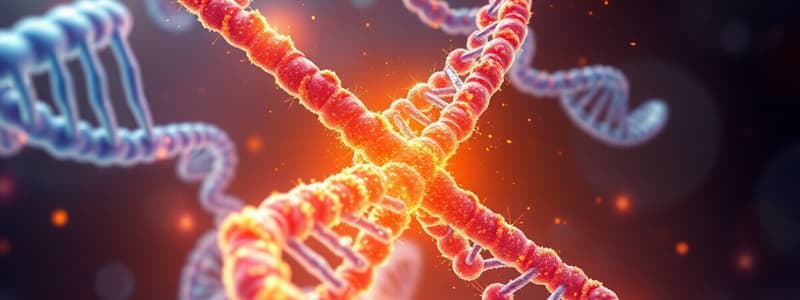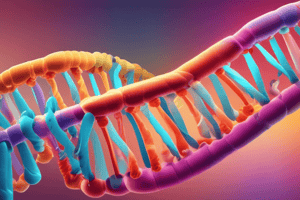Podcast
Questions and Answers
What is the primary element that forms the backbone of an informational biopolymer?
What is the primary element that forms the backbone of an informational biopolymer?
- Characteristic elements
- Functional groups
- Common element (correct)
- Solvent molecules
Which of the following correctly describes the nature of informational biopolymers?
Which of the following correctly describes the nature of informational biopolymers?
- They are primarily lipid-based.
- They are circular.
- They are linear. (correct)
- They can be branched.
What determines the information encoded in an informational biopolymer?
What determines the information encoded in an informational biopolymer?
- Size of the side chains
- Length of the polymer
- Order of the monomer units (correct)
- Type of backbone element
How many types of joining sites must a monomer have to allow for the formation of linear polymers?
How many types of joining sites must a monomer have to allow for the formation of linear polymers?
Which of the following statements is true regarding the characteristic elements in informational biopolymers?
Which of the following statements is true regarding the characteristic elements in informational biopolymers?
Why is it important that informational biopolymers are not branched?
Why is it important that informational biopolymers are not branched?
What does the term 'sequence' refer to in the context of an informational biopolymer?
What does the term 'sequence' refer to in the context of an informational biopolymer?
What is the maximum number of monomer units that can be joined if a monomer has only one joining site?
What is the maximum number of monomer units that can be joined if a monomer has only one joining site?
What are the three main classes of amino acids based on their chemical properties?
What are the three main classes of amino acids based on their chemical properties?
Which nucleotides are incorporated into a growing nucleic acid chain?
Which nucleotides are incorporated into a growing nucleic acid chain?
What type of bonds link amino acids in a protein chain?
What type of bonds link amino acids in a protein chain?
Which statement is true regarding the growth direction of a protein chain?
Which statement is true regarding the growth direction of a protein chain?
What energizes amino acid monomers for incorporation into a growing protein chain?
What energizes amino acid monomers for incorporation into a growing protein chain?
What happens to the outer two phosphates when an NTP is incorporated into the growing nucleic acid chain?
What happens to the outer two phosphates when an NTP is incorporated into the growing nucleic acid chain?
What type of reaction is necessary for linking energized monomers during polymer synthesis?
What type of reaction is necessary for linking energized monomers during polymer synthesis?
Which of the following is NOT a type of NTP?
Which of the following is NOT a type of NTP?
What distinguishes the ends of informational biopolymers?
What distinguishes the ends of informational biopolymers?
What is the direction of polymer growth in informational biopolymers?
What is the direction of polymer growth in informational biopolymers?
Which of the following best describes the main components of nucleic acids?
Which of the following best describes the main components of nucleic acids?
What is a key difference between DNA and RNA nucleotides?
What is a key difference between DNA and RNA nucleotides?
What type of monomers are used to form proteins?
What type of monomers are used to form proteins?
Which statement accurately describes the joining sites of monomers?
Which statement accurately describes the joining sites of monomers?
How is the molecular backbone of nucleic acids formed?
How is the molecular backbone of nucleic acids formed?
What characterizes the circular form of DNA found in some organisms?
What characterizes the circular form of DNA found in some organisms?
Flashcards are hidden until you start studying
Study Notes
Informational Biopolymers: DNA, RNA, and Proteins
- Informational biopolymers like DNA, RNA, and proteins are polymers with a specific sequence of monomers that carries information.
- The monomers in these biopolymers have a common element that forms the backbone and a characteristic element that distinguishes each monomer.
- The common element forms covalent bonds between monomers creating a linear chain while, the characteristic elements form side chains that protrude from the backbone.
- Informational biopolymers grow unidirectionally, with new monomers added to one end.
- This unidirectional growth creates a polarity, with a distinct 5' end and a 3' end for nucleic acids and an amino end and a carboxyl end for proteins.
- The monomers are “energized” to be incorporated into the growing polymer chain. For nucleotides, they are in the form of nucleoside triphosphates (NTPs), and for amino acids, they are in the form of amino acyl-tRNA esters.
- The linkage reaction between monomers is catalyzed by a specific enzyme for each type of biopolymer.
Monomer Structure and Polymerization
- If a monomer has one joining site, it can only form dimers and not polymers.
- If a monomer has two joining sites, it can form linear polymers of potentially infinite length.
- Monomers with three joining sites can create branched polymers, but informational biopolymers are always linear.
- In most cases, linear informational biopolymers have two ends. However, in some cases, the two ends can join, forming a circular but unbranched molecule.
- Informational biopolymers are made from asymmetric monomers with two different joining sites.
Nucleotides
- The nucleotide’s characteristic element is a heterocyclic base.
- The nucleotide’s common element is a pentose sugar phosphate.
- The two joining sites are the 5' phosphate and the 3' hydroxyl.
- DNA and RNA nucleotides are similar, but differ in the pentose sugar. Deoxyribose, found in DNA, lacks the 2' hydroxyl group present in ribose, found in RNA.
Amino Acids
- Amino acids are the monomers of proteins.
- Their chemical properties define three main classes of amino acids: Hydrophobic, Hydrophilic, and Special.
- The link between adjacent amino acids is a peptide bond.
- Protein chains grow by the addition of new amino acids to the carboxyl end.
Polymer Chain Lengths
- Nucleic acids have a wide range of chain lengths: DNA from 10 to 10, and RNA from 20 to 10.
- Proteins also have a wide range of chain lengths, from 100 to 10.
Studying That Suits You
Use AI to generate personalized quizzes and flashcards to suit your learning preferences.




